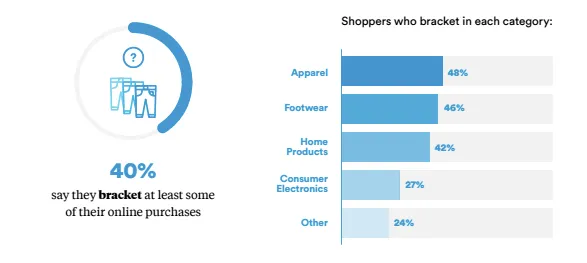
AI-powered delivery date estimates to boost conversion
Give shoppers peace of mind and protect and grow your bottom line
Personalized tracking experiences to build brand loyalty
Returns and exchanges management to mitigate fraud and reward best customers
Proactive communication to drive customer lifetime value
Delivery claim management to tackle fraud and build trust
Bracketing Makes Bedrooms Fitting Rooms

As someone who shops online a lot, I’ve received more apparel, accessory, and footwear deliveries than I can count. But with so much variation in sizing (really, though—how can I be a size 4 in one dress and a 10 in another?), uncertainty about whether specific styles will look good (bell sleeves are not for me, it turns out), and colors that looks incredible on the models but not so hot on me, it’s important that I’m able to buy a lot of options and return anything that a) doesn’t suit me, b) doesn’t fit, or c) I simply don’t like. And to be honest, if a business doesn’t give me the freedom to do exactly that, I likely won’t buy anything from them at all. I’ll admit it: I’m a “bracketer”. But it turns out I’m not alone.
A new trend in online returns.
“Bracketing”—what we call buying multiple versions of a product with the intention of returning at least some of the items—is quickly becoming the go-to for online shoppers. In fact, our 2017 Narvar consumer study on returns revealed that 40% of shoppers (editor's note: we've seen this increase over the years to nearly 60%—see our most recent 2021 State of Returns report for details) bracket at least some of their online purchases, and that apparel and footwear purchases are the most bracketed.

Whether it’s fit, style, color, or pattern, bracketing is about giving your consumer the opportunity to explore different options, and that includes the option to return any and all items that don’t quite hit the mark. The experience ends up becoming exactly like browsing in a retail store— you pick out the items that you like, saunter to the fitting room, and try them on to make sure they look as good on you as they do on the hanger. Basically, bracketing turns your bedroom into a personal fitting room, but instead of try-and-buy, it’s buy-and-try...and return.
Bracketing is a consumer trend that online retailers should pay attention to—even Amazon is making moves to stay ahead of the curve. Returns are simply part of what it means to be an ecommerce business, and the brands that take that into consideration and make the process as seamless as possible for the customer will reap the rewards. Consumers will continue to shop with companies that surprise and delight them through a positive returns experience, and nix the ones that don’t. And it’s some of most desirable consumer cohorts—women, those making more than $100K per year, and millennials under 30—who are leading this trend, which only ups the ante for online retailers with less-than-desirable policies and processes in place.
Turning returns into more sales.
With the right strategy, however, there’s definitely opportunity for retailers to approach these kinds of returns in a way that will help them attract more new customers and keep those who’ve purchased before coming back for more. By recognizing and catering to this evolution in buyer behavior, brands can create a seamless, at-home, and minimal-risk shopping experience for consumers, making this touchpoint an incredibly important one in the overall buyer’s journey. Easy returns will not only simplify the consumer’s life, it will also deliver more value to the brand: in our State of Post-Purchase Experience consumer report, we found that 70% of those we surveyed said that an easy returns experience would make them a repeat customer of a retailer.
The retailers who have stolen my heart and emptied my wallet have flexible return policies, keep me informed throughout the returns journey, and get me my money back as quickly as possible. They keep me as the consumer in mind and make sure I have a positive experience, from item selection and checkout to delivery and, if need be, returns.
To read more about what we learned in our consumer study, download our ebook: “The Essential Guide to Retail Returns”.



Related posts





















